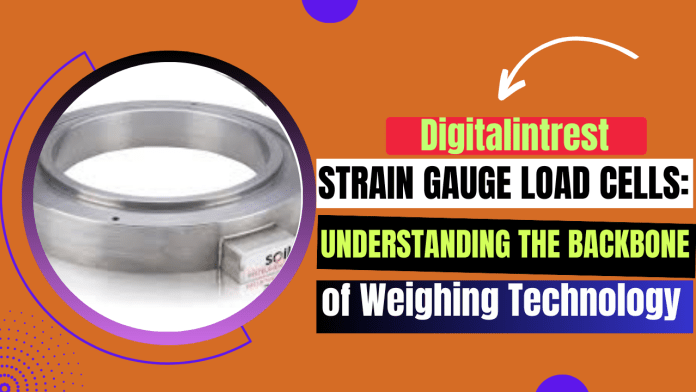Introduction
It is essential that strain gauge load cells are used in the world of weighing technology. These modest instruments serve as the foundation for a wide range of industrial and commercial applications, ensuring precise weight measurements. This article will explore the functions of strain gauge load cells as well as their types, uses, and benefits. In addition, we will look at important factors to consider while selecting, installing, and maintaining these load cells for best performance.
What are Strain Gauge Load Cells?

Transducers called strain gauge load cells are used to translate weight or force into an electrical output. They are frequently used in industrial systems, weighing scales, and several force measurement applications. These load cells work on the same basis as strain gauges, which alter resistance when mechanically deformed.
How Strain Gauge Load Cells Work

The basic operation of strain gauge load cells is based on the concept of electrical resistance variation. When a force is applied, the load cell deforms mechanically, putting tension on the attached strain gauges. Resistance changes correspondingly as the strain gauges stretch or compress. This change in resistance is then turned into an electrical signal, which is measured and shown as weight or force on the measuring device.
Types of Strain Gauge Load Cells

There are primarily four types of strain gauge load cells:
Single-Point Load Cells
S-Beam Load Cells
Shear Beam Load Cells
Compression Load Cells
Each type has its own unique design and application suitability, making them suitable for various use cases.
Advantages of Strain Gauge Load Cells
High accuracy and precision
Compact and Versatile
Cost-Effective
Low Maintenance
Wide Weight Range
Compatibility with Electronic Systems
Durability and longevity
Applications of Strain Gauge Load Cells
Industrial Weighing Scales
Truck Weighbridges
Hoppers and silos
Material Testing
Tank and vessel weighing
Aerospace and automotive testing
Medical Devices
Factors to Consider When Choosing Strain Gauge Load Cells
Maximum Capacity and Sensitivity
Environmental Conditions
Mounting and installation requirements
Overload Protection
Signal Output and Compatibility
Legal Metrology Standards
Proper Installation and Maintenance
Correct mounting procedures
Regular Calibration
Periodic inspection and cleaning
Avoiding Overload and Shock Loading
Troubleshooting Common Issues
Erratic Readings
Zero Drift
Electrical Interference
Physical Damage
Future Innovations in Strain Gauge Load Cells
With advancements in technology, strain gauge load cells are likely to undergo further improvements. Some potential innovations include:
Miniaturization
Wireless Connectivity
Enhanced Durability
Smart Load Cells with Integrated Diagnostics
Conclusion
Strain gauge load cells have transformed the weighing technology business by offering precise and dependable weight measurements. Their flexibility knows no bounds, from industrial applications to medical gadgets. Understanding the principles and types of strain gauge load cells enables organizations to make informed decisions when selecting and deploying these load cells to optimize their processes.
FAQ
Q1: Can strain gauge load cells measure both tension and compression?
A1: Yes, strain gauge load cells can precisely monitor both compression and tension forces, making a variety of applications possible.
Q2: Are strain gauge-loaded cells affected by temperature variations?
A2: Temperature fluctuations can have an impact on the efficiency of strain gauge load cells. It is crucial to select load cells made for particular environmental circumstances.
Q3: Can I recalibrate strain gauge load cells myself?
A3: Making sure load cells are calibrated correctly with the right tools requires the expertise of qualified experts.
Q4: How long do strain gauge load cells last?
A4: Strain gauge load cells can last a long time, usually between 10 and 20 years, with adequate care and use.
Q5: Can strain gauge-loaded cells be submerged in liquids?
A5: Despite the fact that some strain gauge load cells are made for underwater use, it is still important to examine their specifications to ensure compatibility.
